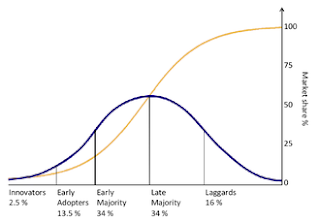Tuesday, 22 February 2011
Losing control of the customer
Everett Rogers published the Diffusion of Innovations in 1962, which clarified how people respond to change and new products.
Companies developed systems for launching innovations and building customer response. The film industry relied on critics to help sell films to audiences. Company web sites included reviews and customer comments. An expert system helped the flow of information and opinions to steer consumers in the desired direction.
What happened?
Amazon and eBay developed systems to include customer reviews on their sites. Consumers became accustomed to giving and receiving feedback from non experts about products and services. Company stooges were relatively easy to spot and ignore in making purchase decisions. These initiatives spawned a range of sites that included consumer reviews and feedback.
What happened next?
Other sites included a forum or discussion boards. Single issue fora focussed discussion around specific products and services. Other web sites included discussion boards about a range of topics and people had space to exchange views on a variety of consumer experiences. Regular visitors to these sites tended to ask fellow members for tips rather than turning to company websites.
What else happened?
Youtube hosted videos that showed how products worked. Some were made by the manufacturers, others by happy or dissatisfied users. Organisations and individuals began to show instruction films on how to do a range of things, including converting Youtube videos to audio files. Some were spoof reviews.
Peer to peer networking increased and companies were viewed as one element of the range of information sources available. Consumers might visit shops or websites to view the product, but looked around for the most competitive price online.
How did organisations respond?
Companies participated in discussion boards in 2 ways: 1) Staff provided helpful information and responded to feedback in positive and constructive ways, 2) Companies took web site hosts to court for publishing inaccurate or defamatory content. Some sites are now more cautious about content provided by consumers in contentious areas. Word gets round about the second tactic and does not boost sales.
Recently I emailed Apple about a problem with their product, which seemed to contravene consumer legislation on description of goods. They fobbed me off by directing me to tech support. I wrote to the Chief Executive (based in the USA) and the UK customer services manager was on the phone to me within a few days. She told me this was the first time she had heard a complaint about this particular problem. I pointed out that people had been discussing the issue for the last 4 years on their own web site fora.
If you don't use your own resources for listening to the customer, then they'll go elsewhere. If you don't or won't provide a solution to their problem, they'll find someone else who will.
Pubs may be closing every week in the UK, but people are finding virtual bars and cafes to gather, build relationships and exchange ideas about products and services. Even government experts no longer dominate:
The late majority and laggards may still respond to conventional systems, but the other 50% of the population comprising innovators, early adopters and early majority have voted with their feet and fingertips.
Russell Ackoff describes the evolution of companies from organisms to communities, in which people below elect their leaders. Perhaps the marketplace is evolving from distinct demographic strata into communities that are proactive and share ideas across demographic boundaries.
Customer relationship management (CRM) has become increasingly complex as customers don't necessarily gravitate to a company's website for information or to complain about their products.
Seller beware!
Subscribe to:
Post Comments (Atom)

No comments:
Post a Comment